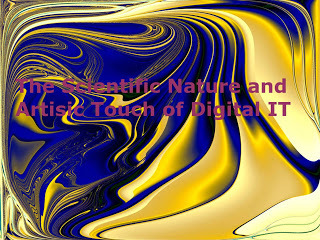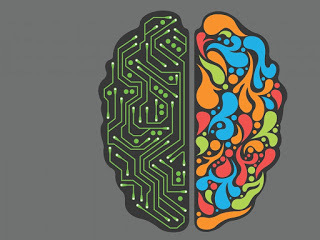Pearl Zhu's Blog, page 1366
February 5, 2016
CIO’s Digital Agenda XXXVIII: Running IT as a Business Value Creator
 In most cases, the IT department isn't producing anything that is saleable and, therefore, many in the organization will view IT as something that seems to ceaselessly suck up money with the little-perceived return. First and foremost a CIO needs to show that IT isn't just a cost center but is a deliverer of value, what’re the effective approaches in doing so?
In most cases, the IT department isn't producing anything that is saleable and, therefore, many in the organization will view IT as something that seems to ceaselessly suck up money with the little-perceived return. First and foremost a CIO needs to show that IT isn't just a cost center but is a deliverer of value, what’re the effective approaches in doing so?
Running IT as a Business Value Creator How to Transform IT from Cost Center into Value Creator: IT can become known as a revenue rainmaker by associating its efforts directly with sources of income. You are able to spot the opportunities to increase revenues. Looking for solutions which will directly benefit the external end customer will improve the competitive advantage and in-turn brings in increased revenue. Business people with revenue-enhancement projects often don't request IT projects to support them because they don't know what IT can do. You have to find these projects and then talk with the business managers responsible for them about what could be done.
Three “V’s in Running a Digital IT: Digital transformation starts with mind shift, business value has to be driven, indicated and understood at all levels of the organization. This is accomplished through establishing strong interdependent relationships, the shared vision and wisdom, the frictionless business culture, the re-framed processes to bridge silo, and the optimal sets of business capabilities to delight customers. IT value is multi-faceted and it’s interesting to see how IT value is in the eye of the beholder.
How can CIOs contribute to revenue generation: With the constant change in the capability of information and technology to serve the business, CIO's role in an enterprise is evolving accordingly. CIO has to foresee, anticipate business needs for information and then prepare and gear up the information systems to not only make readily available pertinent information to top business decision makers but also preempt the need and present the business value. More specifically, here are six ways CIOs can contribute to revenue generation:
Three Aspects for IT as Revenue Generator It almost turns to be mainstream thought that IT needs to be business’s growth engine and revenue generator, but how? What strategies are CIO's using to posture IT as a revenue generating organization in organizations whose primary focus is not IT?
 CIO Debate: How can you Deliver IT Value without Budget? There’s an interesting brainstorming earlier in the CIO forum: “You just got tapped on the shoulder by the boss to spearhead a company-wide deployment of workforce/budget management solutions to every employee. No money and limited skills in IT. What do you do?”. It spurs provocative discussion of the best scenario on how to handle such circumstances and deliver the best value if possible? Though the detailed solution may depend on the size and structure of the enterprise, try to find the pain point for the request and definitely it won’t hurt to take some logic steps
CIO Debate: How can you Deliver IT Value without Budget? There’s an interesting brainstorming earlier in the CIO forum: “You just got tapped on the shoulder by the boss to spearhead a company-wide deployment of workforce/budget management solutions to every employee. No money and limited skills in IT. What do you do?”. It spurs provocative discussion of the best scenario on how to handle such circumstances and deliver the best value if possible? Though the detailed solution may depend on the size and structure of the enterprise, try to find the pain point for the request and definitely it won’t hurt to take some logic stepsThe “Future of CIO” Blog has reached 1.3 million page views with 2500+ blog posting in 59+ different categories of leadership, management, strategy, digitalization, change/talent, etc. The content richness is not for its own sake, but to convey the vision and share the wisdom. Blogging is not about writing, but about thinking; it’s not just about WHAT to say, but about WHY to say, and HOW to say it. It reflects the color and shade of your thought patterns, and it indicates the peaks and curves of your thinking waves. Unlike pure entertainment, quality and professional content takes time for digesting, contemplation and engaging, and therefore, it takes time to attract the "hungry minds" and the "deep souls." It’s the journey to amplify your voice, deepen your digital footprints, and match your way for human progression.Follow us at: @Pearl_Zhu
Published on February 05, 2016 23:12
How do you Define Quality Data
 Corporate IT is the steward of business information system. And information System (IS) is "a system" that deals with Information Management: collecting, storing, and processing data and delivering information, knowledge, and digital products. Too many businesses are data rich but information poor. Or they spend so much time and energy collecting data for that "just in case" scenario. Information Management quality means quality data, quality management, and quality measurement. What are further perspectives about Data Quality?
Corporate IT is the steward of business information system. And information System (IS) is "a system" that deals with Information Management: collecting, storing, and processing data and delivering information, knowledge, and digital products. Too many businesses are data rich but information poor. Or they spend so much time and energy collecting data for that "just in case" scenario. Information Management quality means quality data, quality management, and quality measurement. What are further perspectives about Data Quality?
By “quality data” – it means clean, organized, actionable data from which to extract relevant information and insight: Data quality does not end with managing the incorrect entry of information, but the logic of data has to be taken into account too. You can walk through all the various dimensions of data quality such as accuracy, consistency etc, but business context is indeed a very important perspective. Data can be accurate, consistent, timely, but data can also be shared among many different business groups, it can be transformed, aggregated, derived for various business needs, each with possibly their own views on what the expected definition and quality of the data should be
Data Quality doesn’t mean perfect data but means “good enough” data: Data cleaning and data management has a deep business purpose to turning data into information, the business side of making sense of the raw data, adding value and augmenting business systems. This is where the organizations that understand this true nature will really begin to see huge value gains. In short, Data Quality doesn't mean you pursue the perfect data, but the good enough data being transformed into useful information, business insight, and human wisdom.
 Cleansing the data is often the most difficult and time-consuming part of data science. "Data" is scattered, and needs cleansing and improvement. Data cleansing, transformation and sorting are vital in the data world, because it helps put things in perspective for business to read between the lines with accuracy and clarity of information that is needed for making effective decisions. This can be a major challenge at times depending on the size of the data. Everybody talks about the tools, but nobody asked about the data cleaning/formatting/calculations processes you want to perform. What kind of data cleaning/formatting/calculations do you want to perform? The issue of data quality is much more complex than just algorithms for cleaning up data. One has to consider how error/uncertainty is going to propagate through your analysis models and how the output is fit for making decisions under the specific context of your application.
Cleansing the data is often the most difficult and time-consuming part of data science. "Data" is scattered, and needs cleansing and improvement. Data cleansing, transformation and sorting are vital in the data world, because it helps put things in perspective for business to read between the lines with accuracy and clarity of information that is needed for making effective decisions. This can be a major challenge at times depending on the size of the data. Everybody talks about the tools, but nobody asked about the data cleaning/formatting/calculations processes you want to perform. What kind of data cleaning/formatting/calculations do you want to perform? The issue of data quality is much more complex than just algorithms for cleaning up data. One has to consider how error/uncertainty is going to propagate through your analysis models and how the output is fit for making decisions under the specific context of your application.Quality data is like the Holy Grail, businesses all want to achieve it; but not sure if it’s very doable: Business operates in the real world, and the real world is muddy and chaotic. Organizations need tools that deal with muddy and chaotic data, not a focus on making the data adapt to somewhat weaker tools. All data, from wherever it comes, is legitimate and reflective of the systems that provide it. As such, the data reveals deep and essential truths about not only the business domain it covers but also about the systems that capture it. it, you will not be able to understand the performance of your company or measure it without good quality data. The beauty of data is not for it’s own sake, but to capture the customer’s insight or the business’s foresight from it. Follow us at: @Pearl_Zhu
Published on February 05, 2016 23:09
Three Big “Where”s in Change Management
 Change comes in two forms; good change (improvement) or bad change (deterioration). The good change can drive business growth, and the bad change will deteriorate the business development. And the purpose of Change Management is to enable and accelerate good change, discourage and eliminate bad changes. Change has to be orchestrated at all levels. Besides exploring WHY, WHAT, WHEN, WHO questions about changes, here is the last “W” -Where shall you change?
Change comes in two forms; good change (improvement) or bad change (deterioration). The good change can drive business growth, and the bad change will deteriorate the business development. And the purpose of Change Management is to enable and accelerate good change, discourage and eliminate bad changes. Change has to be orchestrated at all levels. Besides exploring WHY, WHAT, WHEN, WHO questions about changes, here is the last “W” -Where shall you change?
WHERE - Change the game is mindset; people are always the weakest link in any change or transformation effort. Change behaviors often only fix the symptom via manual control, but change mindset can be more innate to make business/digital transformation happen naturally. Hence, the digital mindset assessment is necessary to understand different thinking patterns and styles of employees or candidate, are they mostly systems thinker or intuitive thinker; more analytical or synthetic; more out of box thinker (critical & creative) to break the old rules, or more compliant to follow the orders; think more linear or nonlinear, holistic or mechanical way, etc. Technical competence, development potential, and culture adaptation are powerful together and add an element that is especially important in today's business environment and prepares for the continuous digital dynamic. Digital make a huge impact on talent management, the emergence of social platforms provides the new way to learn, share and collaborate via direct applications at the corporate level. Change occurs at the level of the individual and it is only when the majority of people are on the journey equipped with the “changeable mind,” that the real results start to emerge. It is commonly noted that most of the 'top-down' driven programs are unsuccessful as they fail to enthuse functional stakeholders.
Change needs to be embedded into the mechanism of multiple management disciplines, such as innovation management/project management/talent management etc. Change is the vehicle, not the purpose of doing a project. Change in and of itself is never the reason. Each project will no doubt have an element, process, procedure, associate motivation, win/win requirement, etc., that will require alteration (change), but that does not require the project manager to have change as a primary goal. The true business goals are always related to business growth, customer satisfaction or cost optimization, and then measure twice cut once, know how to measure, monitor and communicate the results of various projects across the enterprise so that all teams can contribute to the continuous improvement.
 Where to change -Process optimization and organizational structure tuning are also the right place to experiment changes for the sake of business agility: Productivity increase comes from effective process or technology, through new functionality can increase efficiency by certain percentage, but the higher percentage of productivity increase would come from bringing effectiveness & efficiency in the areas of processes (reengineering, eliminating waste, architecting new processes, etc.). Organizational structure tuning will also become more practical because digital technologies provide the new way to do thing, more channels to communicate, and how to get the work done. The option to build business physically or run virtually; the option to serve customer via traditional counter or digital channel; the option to work in the large building or the remote office. Always keep in mind of the clear business goals regardless where do you change and how to change it.
Where to change -Process optimization and organizational structure tuning are also the right place to experiment changes for the sake of business agility: Productivity increase comes from effective process or technology, through new functionality can increase efficiency by certain percentage, but the higher percentage of productivity increase would come from bringing effectiveness & efficiency in the areas of processes (reengineering, eliminating waste, architecting new processes, etc.). Organizational structure tuning will also become more practical because digital technologies provide the new way to do thing, more channels to communicate, and how to get the work done. The option to build business physically or run virtually; the option to serve customer via traditional counter or digital channel; the option to work in the large building or the remote office. Always keep in mind of the clear business goals regardless where do you change and how to change it.
Change is inevitable, and there are a lot of place you can make changes. But it’s also important to keep the delicate balance of flow and stability; where to change and how to change it. Change can not be just another thing that needs to be accomplished. It has to be woven into action, process and communication of the organization, and radical changes need to have mindshift. Navigating through these “ 5W+1H” questions does help to clarify change purpose and innovate Change Management scenario.
Follow us at: @Pearl_Zhu
Published on February 05, 2016 23:06
February 4, 2016
The Weekly Insight of the “Future of CIO” 2/5/2016 The Art & Science of Digital Management
 The “Future of CIO” Blog has reached 1.3 million page views with 2500+ blog posting in 59+ different categories of leadership, management, strategy, digitalization, change/talent, etc. The content richness is not for its own sake, but to convey the vision and share the wisdom. Here are a series of presentations about digital leadership, IT Management, and Talent Management.
The “Future of CIO” Blog has reached 1.3 million page views with 2500+ blog posting in 59+ different categories of leadership, management, strategy, digitalization, change/talent, etc. The content richness is not for its own sake, but to convey the vision and share the wisdom. Here are a series of presentations about digital leadership, IT Management, and Talent Management.
The Presentation Sum UP: The Art and Science of Digital ManagementCIO’s 12 Digital Profiles Slides, Blog, Video: The magic “I” of CIO sparks many imaginations: Chief information officer, chief infrastructure officer, Chief Integration Officer, chief International officer, Chief Inspiration Officer, Chief Innovation Officer, Chief Influence Office etc. The future of CIO is entrepreneur driven, situation oriented, value-added, she or he will take many paradoxical roles: both as business strategist and technology visionary, talent master and effective communicator, savvy business enabler and relentless cost cutter, and transform the business into "Digital Master"!
Talent Management Brief: See Through Talent from Different Angles Slides, Blog, Video: People are always the most invaluable asset in businesses. “Hiring the right person for the right position at the right time,” is the mantra of many forward-thinking organizations. The question is how would you define the right people? How do you define wrong, average, mediocre, good, great or extraordinary person? Or put simply, for what should they be right? Traditional Performance Management focusing on measuring what an employee does (mainly being told to do) in a quantitative way is not sufficient to identify high performance or high potential, should we see through talent from different angles?
13 Digital IT Styles Slides, Blog, Video: Many IT organizations are accelerating from the industrial speed to the digital speed, from IT-business alignment shifted to IT-business engagement, integration, and optimization. It also needs to sharpen its image from a back office support center to a front yard of digital innovation with the variety of digital IT styles.
 Future of CIO” 2500 Blog Posting Sum Up Slides, Blog, Video: In the industrial age, CIOs are the second class executive who often does not have a seat at the big table to make strategy, and who spends most of time and resource on “keeping the light on.” However, digital means the increasing speed of changes, data abundance, and hyperconnectivity, technology is often the very disrupter of innovation, and information is the lifeblood of organizations, many forward-thinking organizations empower their CIOs to be the frontrunner, digital transformer, recognize CIOs as communication hub and change agent due to the unique position they hold to oversight business processes, and interweave business capabilities.
Future of CIO” 2500 Blog Posting Sum Up Slides, Blog, Video: In the industrial age, CIOs are the second class executive who often does not have a seat at the big table to make strategy, and who spends most of time and resource on “keeping the light on.” However, digital means the increasing speed of changes, data abundance, and hyperconnectivity, technology is often the very disrupter of innovation, and information is the lifeblood of organizations, many forward-thinking organizations empower their CIOs to be the frontrunner, digital transformer, recognize CIOs as communication hub and change agent due to the unique position they hold to oversight business processes, and interweave business capabilities.Digital Master One-Year Anniversary Sum Up Slides, Video, Blogs: The purpose of “Digital Master” is to envision the multidimensional impact that digital philosophy, technology, and methodology will have on the future of business and human society.
Blogging is not about writing, but about thinking and innovating the new ideas; it’s not just about WHAT to say, but about WHY to say, and HOW to say it. It reflects the color and shade of your thought patterns, and it indicates the peaks and curves of your thinking waves. Unlike pure entertainment, quality and professional content takes time for digesting, contemplation and engaging, and therefore, it takes the time to attract the "hungry minds" and the "deep souls." It’s the journey to amplify diverse voices and deepen digital footprints, and it's the way to harness your innovative spirit.Follow us at: @Pearl_Zhu
Published on February 04, 2016 22:40
Three Big WHOs in Change Management
 People are the center of any Change Management, and people are always the weakest link in any Change Management effort as well. Therefore, the change agent is critical, as they have been an invaluable source of knowledge, business visions, insight, and support etc. But more specifically, who are proactive change players, and why are they so critical in business transformation?Creating positive change is a joint effort, a joint responsibility.
People are the center of any Change Management, and people are always the weakest link in any Change Management effort as well. Therefore, the change agent is critical, as they have been an invaluable source of knowledge, business visions, insight, and support etc. But more specifically, who are proactive change players, and why are they so critical in business transformation?Creating positive change is a joint effort, a joint responsibility.
Change/transformational Leader: He or she is the responsible top manager of the organization, where change has to be implemented. Change the game is a mindset, such transformational leaders can provide the direction as vision, mission, strategy, as well as leadership skills like decision-making, delegation, and monitoring. This role affects most through congruent behavior, continuous endorsement of the change and regular communication to keep the momentum. Keep in mind good managers make tough decisions. If the end state is desirable it is highly probable tough decisions will need to be made.This is a key role that should always be part of the team. It represents the political willingness to go for the change. In almost every case, if this role was not functioning, change failed or was at least delayed in a very costly way. The right leaders know what they want, give clear directions, bring cohesive process, and stand by their word and motivate. One of change pitfalls is that even the people who are advocating change are resistant to change. Leaders do not set a good example to be change players. It is common for people to propose changes that impact others while exempting themselves. This type of approach is guaranteed to be resisted.
Change Champions/agents: Empowering the change agents is critical to real change. Sponsorship & empowerment goes hand in hand with any change initiative. Whoever the sponsor is, it has to be okay for the change agents to fail, but fail forward and learn from failures, so the empowered change agents can take bold steps to drive the changes, from incremental improvement to leapfrogging digital transformation. What a Change Agent most often does is harness the skills, talent, drive, passion and enthusiasm for the whole organization and direct that to a unifying and shared goal. The change agent needs to build meaningful relation until you begin to look inside self to value the strength you never knew you had. There will be bumps and roadblocks along the way, mainly they are those anti-digital mindsets, such as silo thinking (refuse to have cross-functional collaboration); polar thinking (we are right, they are wrong); non-critical thinking (reflexive, not reflective), stereotypical ('looks' like leader, not think as a leader), small thinking (locally right, globally wrong) or simply those 'resistance to change' mind. So the real skill of a Change Agent is the ability to play any role and know which to play, and when. At the same time, a Change Agent cannot achieve effective transformation without motivation.
 Change Players/Change Network: Change is complex and multi-faceted these days, it is more than change agent alone that are essential for transformation. There are perhaps a number of people usually internal to the business appointed by an organization to work with an external/internal Change Manager and act as the "voice of the business," and be the conduit into the business to help with communication, process, and organizational changes.
Change Players/Change Network: Change is complex and multi-faceted these days, it is more than change agent alone that are essential for transformation. There are perhaps a number of people usually internal to the business appointed by an organization to work with an external/internal Change Manager and act as the "voice of the business," and be the conduit into the business to help with communication, process, and organizational changes.
Further, creating positive change is a joint effort, a joint responsibility, that goes beyond the inspirational change leaders and the relentless change agents. It needs to involve your entire team at all levels. That comes from having the right culture, not a one-time change, but exhibiting positive thinking and proper behaviors at all times, to commit to the values and expectations you have for the organization. The change will not happen quickly, but can and should, and will happen over time, regardless of what you do or don't do. You don't just lead change, you live with it. Every team player becomes a change agent, then change is sustained.
. Follow us at: @Pearl_Zhu
Published on February 04, 2016 22:31
Running IT with High Digital “IQ”
 Organizations across industrial sectors are on the journey of digital transformation. Digital IQ is a measure of how well companies understand the value of technology and weaves it into the fabric of their organizations. Therefore, the assessment of the digital maturity of an organization include: Can your company rely on an IT system that is a commodity (standardized usage of technologies), or is the IT system the core of your business? The approach depends on the company business and the role that IT plays in defining its positioning in the market. Here are three “I” aspects in fine tuning digital IQ of IT and overall business:
Organizations across industrial sectors are on the journey of digital transformation. Digital IQ is a measure of how well companies understand the value of technology and weaves it into the fabric of their organizations. Therefore, the assessment of the digital maturity of an organization include: Can your company rely on an IT system that is a commodity (standardized usage of technologies), or is the IT system the core of your business? The approach depends on the company business and the role that IT plays in defining its positioning in the market. Here are three “I” aspects in fine tuning digital IQ of IT and overall business: Digital Innovation: Innovation is to "make meaningful connections": Innovation can be delivered in many different ways. Organizations define what innovation means to them and how they choose or need to deliver, such as business model innovation, culture innovation, structure innovation, products/service/ process innovation. etc. Digital IT is running like an innovation engine to weave process, technology to an overall framework for idea creation and innovation management which will help to sustain progress and minimize the risk of idea flops. It’s also important to avoid these innovation pitfalls: Innovation fails because people start the innovation process without proper sized, prioritized platforms based on consumer needs. They may begin ideation in a host of ways that are founded on new technology, ethnographies, a cross-functional ideation, etc., without truly knowing if they are fishing (ideating) where the fish are. Innovation fails because... there are too many disconnects that occur between the birth of a vision/concept and the process of turning it into a reality. Lack of information actually gathered for the innovative ideas that come up.IT should not just run the business today, but help “grows the business” for tomorrow. IT is not just a set of tools to improve efficiency, but a business solution providers moving from functioning to delight. IT can introduce a 'measure' for assessing the potential for any improvement opportunity, feature enhancement, or initiative to offer a competitive advantage.
 Digital Intelligence: IT is shifting from a technology custodian to an information steward to manage the full data-performance life cycle includes data --> analysis --> decisions --> performance effectively. Analytics is means to the end, not the end. Many information-savvy organizations have invested in tools and created analytic teams to make informed, real-time decisions. Historical data is always relevant and has potential value, but the analysis of the data has no value unless someone decides to act on it. However, in reality, there is not enough focus on decisions. Monetization of analytics efforts is very essential. The insights obtained by data mining needs to be converted into an actionable plan and outcome validated in terms of financial figures. To deliver value from analytics, organizations must turn information into knowledge, insight, and wisdom, enabling making the right decisions at the right time. That is one of the most important responsibilities for digital IT to fulfill. Many CIOs apply analytics to understand what has happened (the "descriptive" view, or the "rear-view" mirror), and to learn from it, then understanding what can happen (the "predictive" view). Some CIOs have even gone a step further and looked at how it should be (the "prescriptive" view), and aligned appropriate technology solutions to support and enable business goals and objectives
Digital Intelligence: IT is shifting from a technology custodian to an information steward to manage the full data-performance life cycle includes data --> analysis --> decisions --> performance effectively. Analytics is means to the end, not the end. Many information-savvy organizations have invested in tools and created analytic teams to make informed, real-time decisions. Historical data is always relevant and has potential value, but the analysis of the data has no value unless someone decides to act on it. However, in reality, there is not enough focus on decisions. Monetization of analytics efforts is very essential. The insights obtained by data mining needs to be converted into an actionable plan and outcome validated in terms of financial figures. To deliver value from analytics, organizations must turn information into knowledge, insight, and wisdom, enabling making the right decisions at the right time. That is one of the most important responsibilities for digital IT to fulfill. Many CIOs apply analytics to understand what has happened (the "descriptive" view, or the "rear-view" mirror), and to learn from it, then understanding what can happen (the "predictive" view). Some CIOs have even gone a step further and looked at how it should be (the "prescriptive" view), and aligned appropriate technology solutions to support and enable business goals and objectives
Digital Investment: Only CIOs put "Chief Investment Officer" hat on, he/she can scrutinize IT effort via the business lens. IT must invest in and leverage appropriate technologies and solutions to generate valuable insights to help their businesses open up new channels of revenue and monetization within the enterprise, their ecosystem, and the industry. The CIO and IT function must be contributing to the future business strategy by leveraging technology as a means to an end, not the end itself. The three keys to presenting IT value are financial returns, return timeline, and risk. Just like any other investment. If you can present IT' project portfolio in a manner similar to an investment portfolio, it makes instant conceptual sense to board and C-level folks. Once you start prattling on about TCO and IT-centric metrics you've lost your audience. If you can show the objective of the investment and the three elements above, you can present IT as a value generator rather than a cost center. It should be preceded by lots of work that shows IT project (and the IT Strategic Plan) links to the business plan. Convincing shareholders about IT values. This is also the right time, to convince the shareholders on new projects by showing them projected benefits to meet the strategy. Try and show how close IT has come to the perceived value that the business has about IT.
IT is, and will continue to be, a critical department. it has become more obvious that data and information stored and processed in the IT boxes is the real source of business innovation. IT is like the digital brain of the organization, its effectiveness and agility will directly boost the business digital IQ, optimize organizational capabilities and improve business competency.
Follow us at: @Pearl_Zhu
Published on February 04, 2016 22:29
February 3, 2016
CIO’s Digital Agenda XXXVII: How to Improve Decision Making Effectiveness
The greatest danger in times of turbulence is not the turbulence; it is to act with yesterday’s logic. -Peter Drucker
 Business problems" are usually difficult. Indeed, part of the difficulty is that businesses often try to use decision-making processes to define the problem, and in doing so often fail to really define the problem. The problem then just becomes the output of decision-making processes. You then try to solve that problem - using more decision-making logic and wonder why the actions we have taken have made the situation worse. The questions to check: Do you distinguish between decision making and possibly 'problem defining' processes? Or does your decision-making processes inherently include a phase for 'problem defining'? Or is it jumbled together and thus confusion is the result?
Business problems" are usually difficult. Indeed, part of the difficulty is that businesses often try to use decision-making processes to define the problem, and in doing so often fail to really define the problem. The problem then just becomes the output of decision-making processes. You then try to solve that problem - using more decision-making logic and wonder why the actions we have taken have made the situation worse. The questions to check: Do you distinguish between decision making and possibly 'problem defining' processes? Or does your decision-making processes inherently include a phase for 'problem defining'? Or is it jumbled together and thus confusion is the result?
How to Improve Decision Making Effectiveness How to Frame the Right Questions for Decision Making-: One of the most important tasks for management is to make decisions, however, across the sectors, many business leaders fail to make effective decisions, or part of problems is that they frame the wrong question; which means they intend to do things right before doing the right things’ or they try to figure out the ‘HOW,” instead of digging through “WHY” first. So first things first, how to frame the right questions for decision making?
The Decision Making Scenario: Either at an individual level or corporate level, people have to make a decision, large or small even at daily basis. The precursor to 'What is the decision' is 'Why do we need a decision', which is preceded by the framing question 'What is the problem that we need to solve.' And then technically, HOW to make better decisions. So the issue of the issue is: decision power is a mind-power. How to improve it?
A Collection of Insightful Decision Quotes: It's very hard for people to make hard decisions because they do not take the time to think about what they believe, or what they stand for... You can't make up your mind because you are not fully committed to what you believe and in what you know to be right. The greatest danger in times of turbulence is not the turbulence; it is to act with yesterday’s logic. -Peter Drucker
 Analytics-based Decision Science: Although decision making is both art and science; intuition and analysis, thinking fast and thinking slow. Due to the complexity and interdependence of digital nature, the decision becomes more science than art, the whole purpose of analytics is to make better decisions based on data, big or small; wide or narrow; you can call it with any name like decision theory, science, and technology. The point is, how can it optimize decision-making scenario and improve decision effectiveness?
Analytics-based Decision Science: Although decision making is both art and science; intuition and analysis, thinking fast and thinking slow. Due to the complexity and interdependence of digital nature, the decision becomes more science than art, the whole purpose of analytics is to make better decisions based on data, big or small; wide or narrow; you can call it with any name like decision theory, science, and technology. The point is, how can it optimize decision-making scenario and improve decision effectiveness?
What’s the Magic Formula to Make the Right Decision?: Having all the facts to make the best decision is a utopia we would all like. But as the saying goes, if you don't move swiftly someone may eat your lunch. Technically, how should you weigh in the data and gut feeling to make the effective decision at the right time?
The “Future of CIO” Blog has reached 1.3 million page views with 2500+ blog posting in 59+ different categories of leadership, management, strategy, digitalization, change/talent, etc. The content richness is not for its own sake, but to convey the vision and share the wisdom. Blogging is not about writing, but about thinking; it’s not just about WHAT to say, but about WHY to say, and HOW to say it. It reflects the color and shade of your thought patterns, and it indicates the peaks and curves of your thinking waves. Unlike pure entertainment, quality and professional content takes time for digesting, contemplation and engaging, and therefore, it takes the time to attract the "hungry minds" and the "deep souls." It’s the journey to amplify your voice, deepen your digital footprints, and match your way for human progression.Follow us at: @Pearl_Zhu
 Business problems" are usually difficult. Indeed, part of the difficulty is that businesses often try to use decision-making processes to define the problem, and in doing so often fail to really define the problem. The problem then just becomes the output of decision-making processes. You then try to solve that problem - using more decision-making logic and wonder why the actions we have taken have made the situation worse. The questions to check: Do you distinguish between decision making and possibly 'problem defining' processes? Or does your decision-making processes inherently include a phase for 'problem defining'? Or is it jumbled together and thus confusion is the result?
Business problems" are usually difficult. Indeed, part of the difficulty is that businesses often try to use decision-making processes to define the problem, and in doing so often fail to really define the problem. The problem then just becomes the output of decision-making processes. You then try to solve that problem - using more decision-making logic and wonder why the actions we have taken have made the situation worse. The questions to check: Do you distinguish between decision making and possibly 'problem defining' processes? Or does your decision-making processes inherently include a phase for 'problem defining'? Or is it jumbled together and thus confusion is the result?
How to Improve Decision Making Effectiveness How to Frame the Right Questions for Decision Making-: One of the most important tasks for management is to make decisions, however, across the sectors, many business leaders fail to make effective decisions, or part of problems is that they frame the wrong question; which means they intend to do things right before doing the right things’ or they try to figure out the ‘HOW,” instead of digging through “WHY” first. So first things first, how to frame the right questions for decision making?
The Decision Making Scenario: Either at an individual level or corporate level, people have to make a decision, large or small even at daily basis. The precursor to 'What is the decision' is 'Why do we need a decision', which is preceded by the framing question 'What is the problem that we need to solve.' And then technically, HOW to make better decisions. So the issue of the issue is: decision power is a mind-power. How to improve it?
A Collection of Insightful Decision Quotes: It's very hard for people to make hard decisions because they do not take the time to think about what they believe, or what they stand for... You can't make up your mind because you are not fully committed to what you believe and in what you know to be right. The greatest danger in times of turbulence is not the turbulence; it is to act with yesterday’s logic. -Peter Drucker
 Analytics-based Decision Science: Although decision making is both art and science; intuition and analysis, thinking fast and thinking slow. Due to the complexity and interdependence of digital nature, the decision becomes more science than art, the whole purpose of analytics is to make better decisions based on data, big or small; wide or narrow; you can call it with any name like decision theory, science, and technology. The point is, how can it optimize decision-making scenario and improve decision effectiveness?
Analytics-based Decision Science: Although decision making is both art and science; intuition and analysis, thinking fast and thinking slow. Due to the complexity and interdependence of digital nature, the decision becomes more science than art, the whole purpose of analytics is to make better decisions based on data, big or small; wide or narrow; you can call it with any name like decision theory, science, and technology. The point is, how can it optimize decision-making scenario and improve decision effectiveness?
What’s the Magic Formula to Make the Right Decision?: Having all the facts to make the best decision is a utopia we would all like. But as the saying goes, if you don't move swiftly someone may eat your lunch. Technically, how should you weigh in the data and gut feeling to make the effective decision at the right time?
The “Future of CIO” Blog has reached 1.3 million page views with 2500+ blog posting in 59+ different categories of leadership, management, strategy, digitalization, change/talent, etc. The content richness is not for its own sake, but to convey the vision and share the wisdom. Blogging is not about writing, but about thinking; it’s not just about WHAT to say, but about WHY to say, and HOW to say it. It reflects the color and shade of your thought patterns, and it indicates the peaks and curves of your thinking waves. Unlike pure entertainment, quality and professional content takes time for digesting, contemplation and engaging, and therefore, it takes the time to attract the "hungry minds" and the "deep souls." It’s the journey to amplify your voice, deepen your digital footprints, and match your way for human progression.Follow us at: @Pearl_Zhu
Published on February 03, 2016 23:29
Three big “WHEN”s in Change Management
 Corporate change can be a simple modification of strategy, a business process improvement or a more radical digital transformation. Either at the individual or organizational level, change is perhaps a one-time project in the static industrial era; but change has to become an ongoing capability at dynamic digital age. Besides three big “WHY” about changes, three big “WHAT”s about changes, three big “HOW” about Change Management, here is the further question - WHEN should you make change happen - there is the time to sow, and the time to reap - How to manage change cycle more effectively?
Corporate change can be a simple modification of strategy, a business process improvement or a more radical digital transformation. Either at the individual or organizational level, change is perhaps a one-time project in the static industrial era; but change has to become an ongoing capability at dynamic digital age. Besides three big “WHY” about changes, three big “WHAT”s about changes, three big “HOW” about Change Management, here is the further question - WHEN should you make change happen - there is the time to sow, and the time to reap - How to manage change cycle more effectively?
Make sure there is dissatisfaction with the current situation: The people that make up the organization must see a compelling need to change from risky practices, obsolete ideas, processes and do so proactively before issues materialize. It also helps when people believe things will improve by changing, innovating, upgrading, etc. . Is there a burning platform or a burning ambition (or both) that compels your business to become much faster, better and mature at delivering change? Change management is how you catalyze employee adoption and usage of change to capture the portion of benefits that depend on people changing how they do their jobs. Being clear on the strategic imperative to change is important (alongside the 'what's in it for me).
Change starts with a "sense of urgency" which can only come from top management: The commitment of top management is very important for any change to be successful. A good idea or culture cannot be developed by persons at the bottom or middle if it is not supported by the Top Management. However, the degree of explicit control that management exerts, or can exert on these individuals is limited, and often, protect them as the revenue generators, thus, diminishing the impact of organizational change initiatives. To get cooperation and not cause problems, you need to find a way to show them that the changes being made are really in their best interests and will make their jobs easier. Change can come from motivated, driven individuals who refuse to allow the people at the top to hold them back. But, it takes considerable determination and internal drive knowing that you may not be rewarded (and may even be penalized) for going against the grain. Thus, the good moment to change is when the top senses the urgency and the bottom feel the pain, and change inertia is minimized via common understanding about the necessity of changes. The change platform approach focuses more on establishing the right enduring organizational values and capabilities to enable continuous improvement; to be embraced by everyone in the lunchroom, sponsored and believed in by the boardroom. Only then are you in a position to consider what learning and development might be appropriate. Do a root cause analysis of the current state to find out how all those gaps you see came about. Genuine buy-in is ever so critical to any change.
 Change is inevitable WHEN “culture starts eating strategy for breakfast”: Change is not for its own sake, focus on the business purpose behind it. Often is the very reason for change, also an important factor to lead change success. The right culture is a prerequisite foundation for implementing the strategy. Culture precedes strategy. An organization's cultural orientation forms the basis for initiating and improving on strategies and sustaining it. A strong culture should have the characteristics of inclusiveness, innovation, learning agile, etc. A too weak culture affects the ability to walk in one direction and fill in the gaps when formal artifacts - such as strategy, processes and org charts - are not good enough. Weak cultures rely on a bureaucracy to enforce rules and regulations that undermine an organization's speed, simplicity, and competitiveness. Great organizations live their values!
Change is inevitable WHEN “culture starts eating strategy for breakfast”: Change is not for its own sake, focus on the business purpose behind it. Often is the very reason for change, also an important factor to lead change success. The right culture is a prerequisite foundation for implementing the strategy. Culture precedes strategy. An organization's cultural orientation forms the basis for initiating and improving on strategies and sustaining it. A strong culture should have the characteristics of inclusiveness, innovation, learning agile, etc. A too weak culture affects the ability to walk in one direction and fill in the gaps when formal artifacts - such as strategy, processes and org charts - are not good enough. Weak cultures rely on a bureaucracy to enforce rules and regulations that undermine an organization's speed, simplicity, and competitiveness. Great organizations live their values!
Change Management is a journey, not just a one-time project, it means the big WHEN about change is not just a particular moment, but a thought-out planning, to identify crisis point, decision point, tipping point, and inflection point of changes, riding ahead of the change curve takes strategy and methodology, people are the weakest link, also the best reason for any changes, so make people as your CORE focal point.
Follow us at: @Pearl_Zhu
Published on February 03, 2016 23:25
Five IT Management Gaps on the Journey of Digital Transformation
 Organizations large and small are on the journey of digital transformations, and IT plays a pivotal role in driving changes and building business capabilities and competencies. Because Information technology is penetrating into every core process of organization; companies that lacked the skills to manage information technology effectively suffered compared with competitors that had mastered those skills. But what are the IT management gaps more specifically, and how to close them to achieve the next level of business maturity?
Organizations large and small are on the journey of digital transformations, and IT plays a pivotal role in driving changes and building business capabilities and competencies. Because Information technology is penetrating into every core process of organization; companies that lacked the skills to manage information technology effectively suffered compared with competitors that had mastered those skills. But what are the IT management gaps more specifically, and how to close them to achieve the next level of business maturity?
The gaps between business perspective and IT understanding: The common pitfall for IT leader is to fail to make the connection between IT and the business, lack the cognizance of how it will actually impact the company's top line and bottom line growth and, therefore, cannot be the enabler that companies need. n order to drastically change IT landscape, IT leaders need to have in-depth understand both technology and business, have a clear technological vision, and have genuine empathy with the users of technology. With a clear vision, passion follows. You must have passion and drive at the core along with these qualities, genuinely curious about Information. A great CIO should be able to not just understand business objectives and priorities, but also be able to break these down and cascade them downstream to his/her team in an IT-comprehensive format. It’s about having problem-solving skills and technological understanding that give you the ability to invent new ways to create or manage information effectively to drive business growth. The world has changed and operational process efficiency needs to be on agenda to see economic prosperity. Cutting out waste such as shrinking the gap between business and IT as described could make a significant contribution and the sooner it starts the better it will be for all involved.
The communication gaps within IT, between functions and across business ecosystem: “Lost in translation” is one of the most common symptoms which create gaps and build walls with the business and across business ecosystem. Sometimes "communicate" means different things to different people. And to communicate you need a common language. Communicate with colleagues in common language. The solution would be communicating and talking to the people at all the ends of the problem/solution right from the sponsor to the end user with rolled up sleeves. It is much better to ensure that you use terms/words that are in common usage in the enterprise, rather than try to introduce a new term; Speaking different ‘dialect’ in organization & society is one of the root causes of miscommunication. Business Fails IT, just like IT fails business: Many organizations are still running at industrial speed -with bureaucratic culture and hierarchical decision-making scenario, business is the sum of pieces, than a holistic whole, functional silos compete for resources, rather than work collaboratively and seamlessly to optimize business. Such silo culture will create numerous blind spot in resources, process, capacity, and capability.More importantly, IT plays a critical role in shaping the culture of innovation, to encourage quality over quantity, continuous learning and innovation, improve business self-management capability, etc.
The decision gaps between “framing the right questions” and “how to answer them”: Though we enter the age of data and information abundance, but many think we are still at the time of “information-rich, and insight poor.” Knowledge is power, but wisdom is a superpower. Decision making takes multidisciplinary wisdom and approach, frame the right questions before answer them. The company's leadership plays a major role in framing the right questions for decision making. The role as leaders needs to incorporate processes before its reflection on how people are thinking about what they're trying to accomplish. Part of the problem about poor decision making and ineffective problem solving has to do with how you frame the question. Inappropriate framing is being the root cause of most bad decisions. It’s also due to the lack of inquisitive minds. People need to ask questions to deepen understanding. So the proper framing, probabilistic reasoning, sensitivity analysis, and value of information and value of control are integrated techniques. It has a combination of analytical/logical thinking up front, that is, to make sure you're including the right information and looking at all the possible options, then, to select the best decision.
The gaps between strategy and the business capabilities to implement it: IT is a critical enabler in building business capabilities, and capability underpins strategy execution. Identify gaps and weigh on the importance of business capability is the prerequisite to oversight business strategy. The maturity of a business capability would be based on the ability to deliver on customer needs or to achieve the desired capability outcome. Organization’s capabilities can be categorized into the competitive necessity and competitive uniqueness. Business capability is an acquired and organized "ability" within a company and takes hard work to put in place; it can therefore not be transferred because of the degree of organizational learning and organization that goes with it, and the set of business capabilities directly decide the overall organization’s competency, and how well they can execute strategy, deliver the value to the customers and build long term winning position.
 The gaps between IT innovation and IT skill gaps: According to industry surveys, IT skills gap is a significant challenge facing IT leaders today, what are exactly the skills gaps and what are the resulting symptoms. The most wanted IT professional is the one who demonstrated he/she can solve the complex problem either technically or from a business perspective. Businesses become over-complex these days, more often than not, the skills gap is caused by candidates not having the appropriate balance of the right technical skills with business/management acumen, or lack of system, critical and creative thinking, interpersonal skills, as at the end of the day, it all means how to solve business problems. So FIT matters. The bottom line is to explore digital talent pipelines, also have realistic expectations and focuses on fit, career development, and succession planning will go a long way to recruiting and retaining employees with the right mindset, attitude, and aptitude to adapt to changing requirements. Furthermore, the lack of innovative IT leadership or the misunderstanding of IT talent requirement from HR is perhaps the root cause to enlarge the talent gaps. Often times IT leaders look narrowly at specific problems and projects developed to solve those business problems, partly because that is the way funding is allocated rather than having a broad view of their enterprise and the longer term strategy for the organization. They fail to develop talent strategy and keep up on standards within their domain that can lead to the holistic enterprise viewpoint and execution of IT strategies that fit within that enterprise viewpoint.
The gaps between IT innovation and IT skill gaps: According to industry surveys, IT skills gap is a significant challenge facing IT leaders today, what are exactly the skills gaps and what are the resulting symptoms. The most wanted IT professional is the one who demonstrated he/she can solve the complex problem either technically or from a business perspective. Businesses become over-complex these days, more often than not, the skills gap is caused by candidates not having the appropriate balance of the right technical skills with business/management acumen, or lack of system, critical and creative thinking, interpersonal skills, as at the end of the day, it all means how to solve business problems. So FIT matters. The bottom line is to explore digital talent pipelines, also have realistic expectations and focuses on fit, career development, and succession planning will go a long way to recruiting and retaining employees with the right mindset, attitude, and aptitude to adapt to changing requirements. Furthermore, the lack of innovative IT leadership or the misunderstanding of IT talent requirement from HR is perhaps the root cause to enlarge the talent gaps. Often times IT leaders look narrowly at specific problems and projects developed to solve those business problems, partly because that is the way funding is allocated rather than having a broad view of their enterprise and the longer term strategy for the organization. They fail to develop talent strategy and keep up on standards within their domain that can lead to the holistic enterprise viewpoint and execution of IT strategies that fit within that enterprise viewpoint. Bridging IT management gaps starts with business leaders’ mind shift: for many traditional organizations, they aren´t yet in the knowledge economy, they continue to act as expected in the economy of scarcity and live in the silos, presenting difficulties to share the insight and wisdom, business as a whole is superior to the sum of pieces, the highly mature IT organizations not only apply the most advanced digital technology into their business but more importantly, they weave all important factors, from shaping the holistic digital mindset to building the high-performing digital organizations. Follow us at: @Pearl_Zhu
Published on February 03, 2016 23:22
February 2, 2016
Three Elements in Innovative Leadership
 Leadership is a key success factor for any organization's success. Due to the complexity, uncertainty, ambiguity and volatility of digital age, innovation is no long a “nice to have,” but “must have” business capability to keep growth momentum and adapt to changes. And the leadership in any organization must have the ability to guide, inspire, innovate, and motivate a group of people toward accomplishing shared visions and goals. What are important elements in innovative leadership though?
Leadership is a key success factor for any organization's success. Due to the complexity, uncertainty, ambiguity and volatility of digital age, innovation is no long a “nice to have,” but “must have” business capability to keep growth momentum and adapt to changes. And the leadership in any organization must have the ability to guide, inspire, innovate, and motivate a group of people toward accomplishing shared visions and goals. What are important elements in innovative leadership though?
Vision: Leadership is about future, it is the foresight to see the future needs of an organization, the commitment to provide whatever effort is necessary to move the organization in the right direction and the grace to do so because it is best for the organization. Visionary leaders spend the present preparing for what they believe they will be doing or needing in the future. They are good at making predictions by building accurate conceptual models that are based on their understanding of current affairs, coupled with their enhanced decision-making abilities, these predictions allow visionaries to create the future. Visionary leadership navigates the organization forward and prepares effectively and efficiently to absorb and accept change in all its forms. Vision is to serve as a leadership enabler, to clear the path - whether that be the elimination of obstacles or to provide coaching and guidance. In such organizations, change does not disrupt and interfere with business as usual; because they have abilities to evolve, adapt and innovate.
Passion: Vision is driving you so you are more hardened to take the hits. Passion keeps you in the game longer as there is an end desire. We all have certain strengths and types of work that energize our minds and motivate us, as well as types of activity we dislike or that bores us. We are all different, so we should take the unique way to pursue the passions. Passion keeps you to be patient, patience relates to tolerance and tolerance gives one the ability to understand the other points of view, so patience is a key ingredient for innovation, until fulfillment or satisfaction of the inner self. Stamina might be a physical requirement to maintain this tenacity. Passion enables vision, determination, and creativity. If you do not have passion for what you do, innovation, and strategy become HARD WORK which in turn DISABLES determination etc. From leadership perspective, this requires a clearly defined and inspiring purpose, but it also requires extending that purpose into the 'real world' with a vision that everyone is on board with. If the vision isn't connected to the purpose, your team will lack direction, lack enthusiasm, lack passion!
 Progression: Leadership is about change and progression. Innovation is progress, and progress itself is a change, either by individual or group efforts or induced by environmental and cultural tangible and intangible forces. Progress is impossible without change, and those who cannot change their minds cannot change anything. If you choose to do nothing about it, nothing happens, but if you start doing something about it, something happens. Be a believer then everything will happen. Without change, one cannot even stagnate, she or he will be on a backward journey. What is considered progress for one, is not progress for another, so sometimes progress cannot truly be considered "PROGRESS" for humans as a species unless it is helping a very large group. The collective progress driven by innovative leadership leapfrogs human society.
Progression: Leadership is about change and progression. Innovation is progress, and progress itself is a change, either by individual or group efforts or induced by environmental and cultural tangible and intangible forces. Progress is impossible without change, and those who cannot change their minds cannot change anything. If you choose to do nothing about it, nothing happens, but if you start doing something about it, something happens. Be a believer then everything will happen. Without change, one cannot even stagnate, she or he will be on a backward journey. What is considered progress for one, is not progress for another, so sometimes progress cannot truly be considered "PROGRESS" for humans as a species unless it is helping a very large group. The collective progress driven by innovative leadership leapfrogs human society.
The spirit comes from the top. Innovative leaders emerge to transform digital businesses. Innovative leadership is essentially anchored on the leader's overall multifaceted resourcefulness and multidimensional competencies to formulate creative (unconventional) alternatives or solutions to resolve problems, to show versatility and flexibility in response to unpredictable or unanticipated circumstances. By etymology, "innovare" signifies "to make germinate seeds," knowing that, go ahead and innovate by inventing your future, and the one of your company’s.
Follow us at: @Pearl_Zhu
Published on February 02, 2016 22:55



